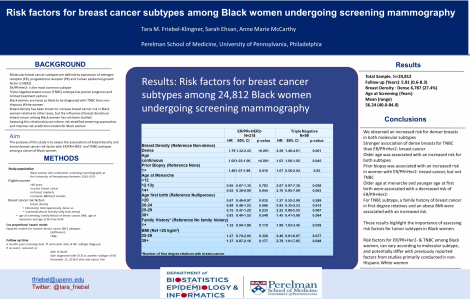Tara Friebel
Association of breast density and breast cancer subtypes among Black women
Abstract
Background: Black women are more likely to be diagnosed with triple negative breast cancer (TNBC), a more aggressive subtype with poorer prognosis than estrogen receptor (ER) and/or progesterone receptor (PR) positive, HER2 negative (ER/PR+HER2-) breast cancer. The association of breast density and breast cancer subtypes among Black women is not known.
Methods: Black women who underwent screening mammography at the University of Pennsylvania between 2010-2015 were included. Eligible women were aged 40-84 years, had no prior breast cancer, no breast implants, and no known BRCA1/2 mutation. Outcomes of interest included ER/PR+/HER2- and TNBC breast cancer subtypes. Women were censored at death, date diagnosed with subtype of breast cancer, or on December 31, 2018 if they were alive and cancer free. Breast density was categorized as extremely or heterogeneously dense vs. scattered or almost entirely fatty. Models were adjusted for known breast cancer risk factors. Cox proportional hazard models were used to estimate hazard ratios and 95% confidence intervals.
Results: Among 24,812 Black women, mean age was 56.2 (40-84) and 328 (1.3%) developed invasive breast cancer during a mean follow up of 5.8 years; 179 (54.6%) of cancers were ER/PR+ HER- and 59 (18.0%) TNBC. Dense breasts increased risk of ER/PR+/HER2- breast cancer by over 40% (HR: 1.46, 95%CI 1.07-1.98) and TNBC more than twofold (HR: 2.77, 1.01-7.65).
Conclusion: We observed an association of breast density for TNBC and ER/PR+ HER2- breast cancer subtypes. These results highlight the importance of assessing risk factors for tumor subtypes for Black women.
Keywords
disparities, breast cancer, TNBCCommenting is now closed.
About Us
To understand health and disease today, we need new thinking and novel science —the kind we create when multiple disciplines work together from the ground up. That is why this department has put forward a bold vision in population-health science: a single academic home for biostatistics, epidemiology and informatics.
© 2023 Trustees of the University of Pennsylvania. All rights reserved.. | Disclaimer



